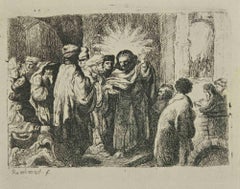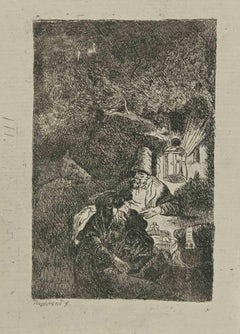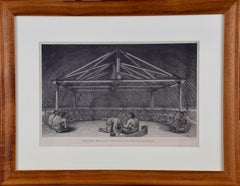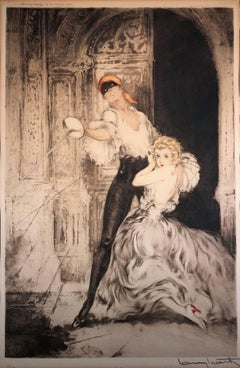Charles Amand Durand Interior Prints
French, 1831-1905
Charles Amand Durand, (1831-1905) is recognized and praised for accomplishing the difficult task of renewing original copper plate designs made by Rembrandt. It is by Amand that many of Rembrandt's works were saved. He also restored plates by Albrecht Durer, Beham, and other various Old Masters from the 15th, 16th, and 17th centuries. The task started when the main curator of the Louvre gave Amand Durand the important mission of restoring the worn down and fragile engravings made by Rembrandt. This is a printing from the Durand plates. Published in "Eaux-Fortes et Gravures des Maîtres anciens, Tirées Des Collections Les Plus Célèbres" by Edouard Lièvre and Georges Duplessis.to
2
Overall Width
to
Overall Height
to
2
113
107
79
36
32
2
2
2
2
1
1
2
1
Artist: Charles Amand Durand
The Tribute Money - engraving after Rembrandt - 19th Century
By Charles Amand Durand
Located in Roma, IT
The Tribute Money is an engraving on ivory-colored paper realized after Rembrandt by Charles Amand Durand (1831-1905) after an etching by Rembrandt. This wonderful piece of art belo...
Category
19th Century Old Masters Charles Amand Durand Interior Prints
Materials
Engraving
The Rest on the Flight into Egypt - engraving after Rembrandt - 19th Century
By Charles Amand Durand
Located in Roma, IT
The Rest on the Flight into Egypt is an engraving on ivory-colored paper realized after Rembrandt by Charles Amand Durand (1831-1905) after an etching by Rembrandt. This wonderful pi...
Category
19th Century Old Masters Charles Amand Durand Interior Prints
Materials
Engraving
Related Items
"King of the Friendly Islands" (Tonga); Engraving from Captain Cook's 3rd Voyage
By John Webber
Located in Alamo, CA
"Poulaho, King of the Friendly Islands, Drinking Kava" is an engraving created by William Sharp (1749-1824), from a drawing by John Webber (1752-1793), who was the artist on Captain James Cook's 3rd and final voyage of discovery. It was published in the atlas of "A Voyage to the Pacific Ocean Undertaken by the Command of His Majesty, for Making Discoveries in the Northern Hemisphere", the official British Admirality sanctioned journal published upon completion of the voyage in London in 1784 by Strahan & Cadell.
Captain Cook visited Tonga on his 3rd voyage, which he named The Friendly Islands because of the warm welcome he and his crew received, unlike some of the other more hostile Pacific islands. The engraving depicts Cook and his men observed a kava ceremony at the village of Mu’a on Tongatapu. King Paulaho sits in the centre foreground, his back to the spectator with a man kneeling before him. The ceremonial mat depicted behind Paulaho indicates that nobody was allowed to sit behind him. The figure in the centre holds a single cup, referring to the Tongan custom of offering the cup to the king first. Kava is native to the islands of the South Pacific and was first described for English readers in 1768 by Captain James Cook. The kava root has been used for centuries as a central feature of ceremonies and celebrations because it was able to bring about a calming and pleasant social atmosphere. The root was crushed and processed into coconut milk to become the focal ceremonial beverage, simply referred to as kava.
This engraving is presented in a Koa wood frame and a white mat. Koa wood is legendary in Hawaii. There are occasional faint spots, but the print is otherwise in very good condition. This amazing Koa wood is native to Hawaii and it is known for the deep rich colors and varied grain pattern. Koa has an honored heritage in Hawaii and is highly revered and sacred. The word “koa” means “warrior” in Hawaiian. The warriors of King Kamehameha the Great, created canoes and weapons from a wood plentiful on the Big Island of Hawaii. This wood became synonymous with the warriors themselves, and it became known as koa.
There are three other engravings listed from the official journal of Captain Cook's 3rd voyage available that are presented in identical Koa wood frames and mats (LU117324682422, LU117324684052, LU117324684032). They would make a wonderful grouping for a display of 2, 3 or 4 prints. A discount is available for a grouping depending on the number of items included.
Captain Cook is remembered as one of the greatest explorers and navigators in history. His explorations included Australia, New Zealand and islands of the South Pacific and the northwest coast of North America. Hawaii was discovered by Captain Cook during this voyage. Hawaii was originally called The Sandwich Islands in honor of The Earl of Sandwich...
Category
1780s Realist Charles Amand Durand Interior Prints
Materials
Engraving
$2,375
H 18.25 in W 23.5 in D 0.88 in
Don Juan
By Louis Icart
Located in Missouri, MO
Aquating Engraving
Image Size: approx. 20 1/4 x 13 3/8
Framed Size: 28 x 20.5 inches
Pencil Signed Lower Right
Louis Justin Laurent Icart was born in Toulouse in 1890 and died in Paris in 1950. He lived in New York City in the 1920s, where he became known for his Art-Deco color etchings of glamourous women.
He was first son of Jean and Elisabeth Icart and was officially named Louis Justin Laurent Icart. The use of his initials L.I. would be sufficient in this household. Therefore, from the moment of his birth he was dubbed 'Helli'. The Icart family lived modestly in a small brick home on rue Traversière-de-la-balance, in the culturally rich Southern French city of Toulouse, which was the home of many prominent writers and artists, the most famous being Henri de Toulouse-Lautrec.
Icart entered the l'Ecole Superieure de Commerce de Toulouse in order to continue his studies for a career in business, particularly banking (his father's profession). However, he soon discovered the play writings of Victor Hugo (1802-1885), which were to change the course of his life. Icart borrowed whatever books he could find by Hugo at the Toulouse library, devouring the tales, rich in both romantic imagery and the dilemmas of the human condition. It was through Icart's love of the theater that he developed a taste for all the arts, though the urge to paint was not as yet as strong for him as the urge to act.
It was not until his move to Paris in 1907 that Icart would concentrate on painting, drawing and the production of countless beautiful etchings, which have served (more than the other mediums) to indelibly preserve his name in twentieth century art history.
Art Deco, a term coined at the 1925 Paris Exposition des Arts Decoratifs, had taken its grip on the Paris of the 1920s. By the late 1920s Icart, working for both publications and major fashion and design studios, had become very successful, both artistically and financially. His etchings reached their height of brilliance in this era of Art Deco, and Icart had become the symbol of the epoch. Yet, although Icart has created for us a picture of Paris and New York life in the 1920s and 1930s, he worked in his own style, derived principally from the study of eighteenth-century French masters such as Jean Antoine Watteau, François Boucher and Jean Honoré Fragonard.
In Icart's drawings, one sees the Impressionists Degas...
Category
1920s Art Deco Charles Amand Durand Interior Prints
Materials
Engraving, Aquatint
'Jesus and the Woman at the Well, ' by Amand-Durand, Engraving
By Armand Durand
Located in Oklahoma City, OK
This early 19th century framed 35" x 31" engraving by artist Amand-Durand depcits an etching of 'Jesus and the Woman at the Well,' after the Dutch master, Rembrandt van Rijn. This poignant Biblical story is depicted by Arman-Durand in Rembrandt style...
Category
Early 19th Century Old Masters Charles Amand Durand Interior Prints
Materials
Engraving
$1,200 Sale Price
20% Off
H 30.5 in W 26.5 in D 1.5 in
The Roman Colosseum: A Framed 18th Century Etching of the Interior by Piranesi
By Giovanni Battista Piranesi
Located in Alamo, CA
This large framed 18th century etching by Giovanni Battista Piranesi entitled "Veduta dell'interno dell'Anfiteatro Flavio detto il Colosseo" (View of the interior of the Flavian Amph...
Category
1760s Old Masters Charles Amand Durand Interior Prints
Materials
Etching
$5,875
H 28.88 in W 37.25 in D 1.25 in
Church of St. Costanza, Rome: An 18th Century Piranesi Architectural Etching
By Giovanni Battista Piranesi
Located in Alamo, CA
This is a framed 18th century Giovanni Battista Piranesi etching entitled: "Veduta interna del Sepocro di Santa Costanza, fabbricat...
Category
1770s Old Masters Charles Amand Durand Interior Prints
Materials
Etching
$3,775
H 27 in W 32 in D 1.5 in
Ancient Roman Marble Vase: 18th C. Piranesi Etching Vaso Cinerario di Gran Mole
By Giovanni Battista Piranesi
Located in Alamo, CA
"Vaso Cinerario di Gran Mole. Le Teste dei Giovenchi mostrano di reggere it pesante Festone composto di Frutti Fiori Grans ed use. Il tuto Necefsario all Vita Umana. Il Restante degl...
Category
1760s Old Masters Charles Amand Durand Interior Prints
Materials
Etching
Academie de l’Espee Tabula 2 prints Girarld Thibault Tab. XXXIII & Tab.IIII
By Pierre Thibault
Located in Paonia, CO
Two hand colored engravings from the Academie de l’Espee ( full title can be translated as Academy of the Sword: wherein is demonstrated by mathematical rules on the foundation of a mysterious circle the theory and practice of the true and heretofore unknown secrets of handling arms on foot and horseback ) by Girard Thibault...
Category
Early 17th Century Other Art Style Charles Amand Durand Interior Prints
Materials
Engraving
$720 Sale Price
20% Off
H 25 in W 36 in
A Framed 18th C. Piranesi Etching of an Ancient Marble Vase from Hadrian's Villa
By Giovanni Battista Piranesi
Located in Alamo, CA
This large framed 18th century etching by Giovanni Battista Piranesi is entitled "Vaso antico di Marmo adornato di eccellenti Sculture si nella parte anteriere che nell' opposta, le ...
Category
1770s Old Masters Charles Amand Durand Interior Prints
Materials
Etching
$3,975
H 42.25 in W 26.5 in D 1.5 in
James Dobie "The New Will" Color Engraving After Walter Dendy Sadler c.1894
Located in San Francisco, CA
James Dobie "The New Will" Color Engraving After Walter Dendy Sadler c.1894
Original 19th century color engraving
Engraved by James Dobie after artwork b...
Category
Late 19th Century Charles Amand Durand Interior Prints
Materials
Engraving
$375
H 23.5 in W 28 in D 2 in
Original AJANTA INDIA Bodhisattva Padmapani vintage travel poster 1959
Located in Spokane, WA
Original Ajanta India vintage travel poster from 1959. Archival linen backed in Grade A condition, ready to frame. Note that a later edition of this poster was printed but the im...
Category
1950s Old Masters Charles Amand Durand Interior Prints
Materials
Lithograph
$995
H 39.5 in W 24.25 in D 0.3 in
William Hogarth's "Analysis of Beauty": A Set of Two Framed 18th C. Engravings
By William Hogarth
Located in Alamo, CA
The two plates in this set were created utilizing both engraving and etching techniques by William Hogarth in 1753, originally as illustrations of his book on aesthetics, entitled "Analysis of Beauty". Due to their popularity, these plates were later published separately. The publication line in the lower right reads: "Designed, Engraved, and Publish'd by Wm. Hogarth, March 5th 1753, according to Act of Parliament." Hogarth's original copper plates were refurbished where needed by James Heath and engravings were republished in London in 1822 by Braddock, Cradock & Joy. This was the last time Hogarth's copper plates were used for printing. Most were melted during World War I for the construction of bombs.
These large folio sized "Analysis of Beauty" engravings are presented in antiqued gold-colored frames with double mats; the outer silk mats are light brown-colored and the inner mats are dark brown. Each frame measures 27.38" x 31.25" x 1.13". There is one tiny spot in the right margin of plate 1 and another in the lower margin; the latter could be from the printing process. The prints are otherwise in excellent condition.
The "Analysis of Beauty" series is in the collection of many major museums, including: The British Museum, The Metropolitan Museum of Art, The Tate Museum, The Chicago Art Institute and The Fine Arts Museums of San Francisco.
The first engraving (Plate 1) depicts a courtyard of statues which is filled with some of the most famous works of classical sculpture. The most important sculptures are surrounded by less impressive works. The Medicean Venus (#13) is in the center with a statue of Julius Caesar (#19) to the right, elevated on a pulley with a short, overdressed Brutus stands over the falling Caesar. The Apollo Belvedere (#12) is next. A judge stands to the right with his foot on a cherub (#16). Another crying cherub holds a gallows and wipes his tears with the judge's robe.
A sphinx (#21) and the drunken Silenus (#107) are below the Venus. Michaelangelo's torso (#54) and a statue of Antonius (#6) are seen in the foreground. The Farnese Hercules (#3) and a bust of another Hercules (#4) under two statuettes of Isis are also included in the scene.
The key to these objects is included in the form of a serpentine line winding around a cone (#26), Hogarth's "Line of Beauty". For Hogarth the winding line is an essential element of beauty in art. Hogarth's theory of beauty is communicated in this plate.
Plate 2 is thought to represent the Wanstead Assembly, with the Earl of Tynley and his household. It is an adaptation of a scene in the Happy Marriage series, which complements Hogarth's Marriage à la Mode...
Category
Mid-18th Century Old Masters Charles Amand Durand Interior Prints
Materials
Engraving, Etching
$2,975
H 27.38 in W 31.25 in D 1.13 in
18th Century Etching of Ancient Roman Architectural Objects by Giovanni Piranesi
By Giovanni Battista Piranesi
Located in Alamo, CA
A. Tigna Protensa Super Media Epistylia, B. Praecisiones Tigorum Quaqua Versus Extrinsectus Apparentium, C. Opae Extremitates Tigorum Contintes, Fig. I, plate 88 from "Vasi, Candelab...
Category
Mid-18th Century Old Masters Charles Amand Durand Interior Prints
Materials
Etching
$1,975
H 25.63 in W 19.13 in D 1.25 in
Charles Amand Durand interior prints for sale on 1stDibs.
Find a wide variety of authentic Charles Amand Durand interior prints available for sale on 1stDibs. You can also browse by medium to find art by Charles Amand Durand in engraving and more. Much of the original work by this artist or collective was created during the 19th century and is mostly associated with the Old Masters style. Not every interior allows for large Charles Amand Durand interior prints, so small editions measuring 4 inches across are available. Customers who are interested in this artist might also find the work of Giovanni Battista Piranesi, and Rembrandt van Rijn. Charles Amand Durand interior prints prices can differ depending upon medium, time period and other attributes. On 1stDibs, the price for these items starts at $318 and tops out at $334, while the average work can sell for $326.



